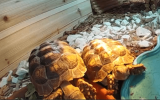FoldintheCheese
New Member
I intervened to rescue two sulcatas in poor conditions. I know pairs are not a good idea. We're keeping one, but the second one I am rehoming. I've been calling him(?) "BB" for "Big and Bossy." They are both too young to sex from what I've read, but I think BB is a boy b/c he has a longer tail and moves it to the side.
They leave each other alone 95% of the day, but BB doesn't hesitate to climb over, wedge in front of, wedge next to the other one, and he mounts the other one 1-3x a day. BB soaks more, eats more, and basks more with the other one avoiding them or sitting still stopping what they were doing. Same age, but clearly BB has been eating more for a while. That said, it's been 2 days and they both seem hydrated, eating, and pooping, so not all bad.
It's a temporary situation, but I'm looking at probably 2-4wks before BB moves on. I can cut some wood and split the habitat in half, but they would each have 1/2 the space to roam. I know pairs aren't good. Which is better-- sharing a bigger space (24x48" for 2 6" sulcatas) or private and small (2x2' per 6" sulcata)? I can try it and see how it goes, but they've already been through so much already. I don't know if the smaller space would be more distressing.
They leave each other alone 95% of the day, but BB doesn't hesitate to climb over, wedge in front of, wedge next to the other one, and he mounts the other one 1-3x a day. BB soaks more, eats more, and basks more with the other one avoiding them or sitting still stopping what they were doing. Same age, but clearly BB has been eating more for a while. That said, it's been 2 days and they both seem hydrated, eating, and pooping, so not all bad.
It's a temporary situation, but I'm looking at probably 2-4wks before BB moves on. I can cut some wood and split the habitat in half, but they would each have 1/2 the space to roam. I know pairs aren't good. Which is better-- sharing a bigger space (24x48" for 2 6" sulcatas) or private and small (2x2' per 6" sulcata)? I can try it and see how it goes, but they've already been through so much already. I don't know if the smaller space would be more distressing.
